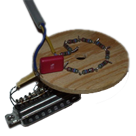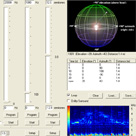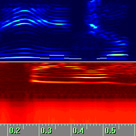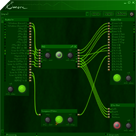Kari Rauta
For the short version, have a look at my CV. If you wish to know more about me and what I've been busying myself with, keep reading!
I've been developing software now for over thirty years, and would describe myself professionally as a
software craftsman. (more info)
While writing software is not my whole life and perhaps not even the most defining aspect of it, I'll focus on that side of myself here.
To give you a better idea my inspirational roots, I'll just skip over the years of professional software development and dive further into history...
 Nokia MikroMikko 1 M6: Intel 8085 CPU @ 3 MHz, two 640 kB floppy drives, 64 kB RAM. Still works!
When looking back into my computing past, I'd have to start with MikroMikko 1 - my first PC and probably the primary reason why I became a programmer.
Nokia MikroMikko 1 M6: Intel 8085 CPU @ 3 MHz, two 640 kB floppy drives, 64 kB RAM. Still works!
When looking back into my computing past, I'd have to start with MikroMikko 1 - my first PC and probably the primary reason why I became a programmer.
It was 80's, I was a teenager and my best friend had a Commodore 64 filled with all sorts of groovy games that were woefully absent from my Mikko.
Even the very nice high resolution display (800*327 black/green pixels) didn't bring much confort, as the available graphics software was mainly oriented towards
drawing occassional pie charts. Consequently, throughout many nights of my youth was the pale glow of emerging software shining from beneath my door as I learned to program with
Assembler, Basic and C (Pascal as well) to have games, graphics editor, vector fonts, file editors, high-resolution printing, more games, better games,
some self-modifying code for plotting mathematical functions, graphical demos (Real Oldskool!), animation scipting, 3D modeling application and so on.
I even wrote a piece of software for drawing fractals based on Mandelbrot and Julia sets, with integrated saving and loading of calculated images using
a self-designed lossless run-length encoding compression algorithm... It took more than a day just to calculate the initial zoom level of the Mandelbrot set! :)
As the speed and capabilities of Intels processors grew with the 80286, 80386 and Pentium CPUs, I became increasingly interested in the
evolving possibilities with digital audio that these new machines could provide. I built a couple of versions of 'covox', a simple DA-converter attached
to the parallel (printer) port of a PC and, when connected to an external amplifier, would provide much superior audio quality compared to the internal speakers
of the PCs of the time. On the software side, I had a long running project of an audio editor that was eventually capable of handling
up to 16-bit stereo sounds. Digital samples were short in duration and often poor in quality, but they were used in genius ways for composing 'mods', songs
based on sample patterns and various ways of manipulating the samples on the fly. Here's one I made back in 1993.
When sound cards and the revolution of consumer digital audio finally arrived, it swept me into the exiting world of real-time signal processing and audio visualization: FFTs, filters,
modulations, pitch shifting, spatialization with Head-Related Transfer Functions, and virtual instruments (physical modeling of musical instruments).
I've been developing software now for over thirty years, and would describe myself professionally as a software craftsman. (more info)
While writing software is not my whole life and perhaps not even the most defining aspect of it, I'll focus on that side of myself here.
To give you a better idea my inspirational roots, I'll just skip over the years of professional software development and dive further into history...
 Nokia MikroMikko 1 M6: Intel 8085 CPU @ 3 MHz, two 640 kB floppy drives, 64 kB RAM. Still works!
Nokia MikroMikko 1 M6: Intel 8085 CPU @ 3 MHz, two 640 kB floppy drives, 64 kB RAM. Still works!
It was 80's, I was a teenager and my best friend had a Commodore 64 filled with all sorts of groovy games that were woefully absent from my Mikko. Even the very nice high resolution display (800*327 black/green pixels) didn't bring much confort, as the available graphics software was mainly oriented towards drawing occassional pie charts. Consequently, throughout many nights of my youth was the pale glow of emerging software shining from beneath my door as I learned to program with Assembler, Basic and C (Pascal as well) to have games, graphics editor, vector fonts, file editors, high-resolution printing, more games, better games, some self-modifying code for plotting mathematical functions, graphical demos (Real Oldskool!), animation scipting, 3D modeling application and so on. I even wrote a piece of software for drawing fractals based on Mandelbrot and Julia sets, with integrated saving and loading of calculated images using a self-designed lossless run-length encoding compression algorithm... It took more than a day just to calculate the initial zoom level of the Mandelbrot set! :)
During school years I spent way too much time having fun with experimental computer graphics,
including things like ray tracing, stereograms, stereoscopic 3D, fractals, fast drawing algorithms and demoscene.
As the main exercise of the course "Computer Graphics" at HUT, I ported one of my older projects to Windows with some added features.
It was renamed to "Function for Windows", and it basicly animates user-defined function surface projections, with optional 3D stereoscopy and simple scripting for transformations.
There are also a couple of audio visualization modes available: amplitude and spectrogram views.
Try it out if you wish, and teach it some new functions while you are at it!
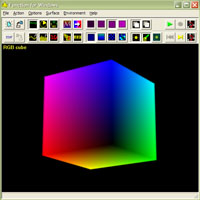


Here's another exercise from school years, created together with Pekka Rapinoja: Virtual Spa
(requires Cortona 3D VRML plugin, download here)
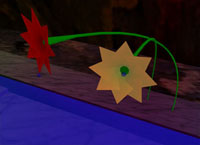

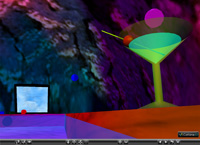
Hopping back to the present day, there are still quite a few hobby projects in my mind to try out some day: experimenting with
genetic/fractal algorithms, writing a VST plugin / Bmore add-on for Vector Base Amplitude Panning,
finishing one more game/music/education/art app that I have an idea for...
Who knows, maybe something from this list will play a part in a future project of Ferrit.
If you have one in mind, don't hesitate to contact me!









